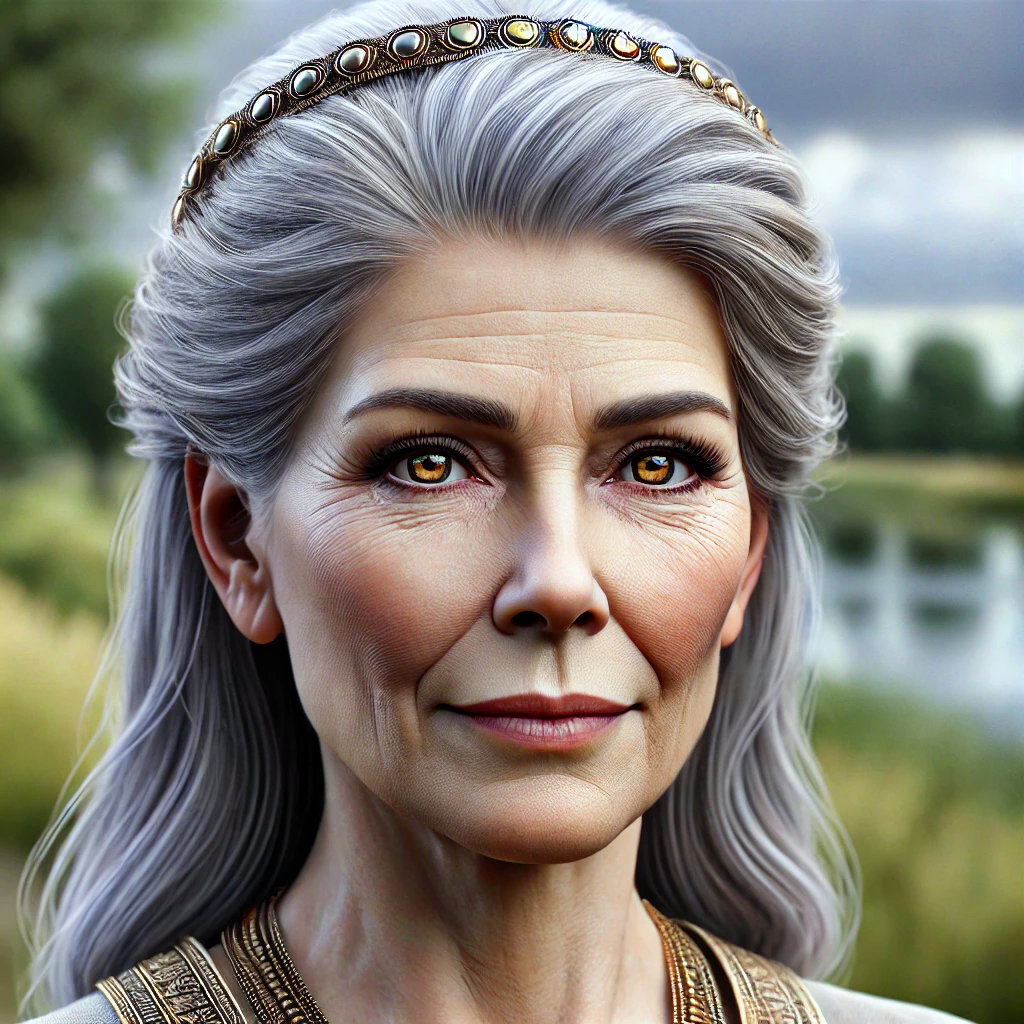The Goddess Ninhursag
Ninhursag belongs to the highest level of the Anunnaki and is one of the most powerful Sumerian goddesses. As the goddess of the earth and “mother of all life,” she regulates life processes from fertility to the development of consciousness. Her titles include Ki (Earth), Aruru (Creator), Belet-ili, and Mami (Mother Goddess). In mythology, she created the conditions for life together with Enki, further developed human consciousness, and acted as a healer. After the flood, she introduced new regulatory mechanisms for population growth.
The Goddess Ninhursag
Position in the Pantheon
Ninhursag belongs to the uppermost level of the Anunnaki and appears as one of the most powerful goddesses of the Sumerian pantheon. As earth goddess and “Mother of All Life,” she is responsible for regulating life processes on Earth — from making the soil fertile to facilitating births to developing human consciousness. This comprehensive responsibility is reflected in her various titles: As Ki she embodies the physical earth itself, as “Aruru” (Creator) she works on the cognitive development of humans, as “Belet-ili” (Lady of the Igigi Gods) she intervenes regulatively when the Igigi were overwhelmed with their work, and as “Mami” (Mother Goddess) she regulates births and population growth. Besides this, she is also known as a healer.
The goddess Ninhursag thus seems to have been responsible for optimizing life processes on Earth. Her mythological roles as earth goddess, healer, birth goddess, and developer of human consciousness can be understood as different aspects of this overarching regulative function. This regulation took place on several levels:
- On the physical level as earth goddess, she created the basic conditions for life together with Enki
- On the medical level as healer and birth goddess, she improves the health and fertility of humans
- On the neural level, she works as creator on the development of human consciousness
Character and Appearance
Ninhursag is portrayed as an experienced and wise goddess who caringly intervenes in life processes. She is often portrayed as about a 70-year-old woman, whose age lies between that of An and that of Enki, which corresponds to her position as An’s original wife and later wife of Enki. In depictions, she is often shown in elaborate, richly decorated garments and with jewelry that underscore her high position.
Her personality is characterized by a deep understanding of the needs of all living beings. She acts as an expert who improves the living conditions of humans.
Ninhursag’s most important cult center was in the city of Kesh, where her main temple stood. She was also worshipped as the main goddess in Adab and had a significant temple there. In addition, there were temples for her in many other Sumerian cities, which corresponded to her superior significance as earth goddess and ‘Mother of All Life.’
Resume
The earliest mythological episode shows Ninhursag as Ki, the earth goddess and wife of the sky god An. As reported in the myth “Enki and Ereshkigal,” she gives birth to Enlil, who later causes the separation of his parents, whereby heaven and earth also separate. This separation of heaven and earth marks the beginning of the world as we know it, but also leads to a fundamental imbalance — as earth goddess alone, she can only produce a dry wasteland. In the myth “Enki and Ninhursag,” it is described how she balances this imbalance through her connection with Enki, the god of fresh water. Together they first create the paradisiacal land of Dilmun, a model for the ecological balance that they later want to establish throughout Sumer. The consequences of their cooperation are described in the myth through Ninhursag’s words:
“I feel the power of life pulsing within me and manifesting on my surface, while I joyfully give birth to and nourish the marshes and reed fields that will henceforth harbor fish, plants, animals and everything that breathes.”
Besides her work as creator god, Ninhursag also accomplished quite practical things, such as healing the sick. When Ninhursag had healed Enki of an illness, he described it as follows:
“You healed me by sending your soul into my body.”
Ninhursag was also able to emotionally bind people to each other. She confirmed this indirectly when she promised her husband Enki not to do it to him:
“I would never bind you to me against your true will, beloved.”
When these things were clarified, Enki and Ninhursag made a resolution:
“I, Enki, lord of the fresh waters, say that from this strong and solid rock (which you have erected for us both and) which means life, love and fertility for me, the waters of life will flow forever into all worlds into which we venture.”
A new era begins when Ninhursag gives her son Enlil the tablets of destinies, as described in the Anzu Myth. These tablets enable Enlil to commission the Igigi with building the canal system and the first cities. The Atrahasis Epic reports how the Igigi performed this work for several thousand years until they finally rebelled. Thereupon the gods agreed to give humans more intelligence so they could take over the heavy work of the Igigi. In this crisis, Ninhursag’s most important ability is shown: Together with Enki, she gives humans more intelligence and used the consciousness of the Igigi as a template.
Subsequently, work as a healer and birth helper also belonged to her main tasks. In her new role as healer and birth helper, Ninhursag contributes to the rapid growth of the human population, which eventually leads to critical overpopulation. The gods had to send the deluge to decimate the population again. Ninhursag’s deep emotional reaction to the deluge in the Atrahasis Epic shows her close connection with all life:
“The lips of Ninhursag, the great lady, were encrusted with frost […] Now my offspring have become like white sheep. As for me, how shall I live in a house of loss?”
The deluge marks a fundamental change in Ninhursag’s work. After the deluge, she introduces a new system for regulating population growth together with Enki. Births are no longer directly supervised by her, and the Pasittu demon is allowed to snatch children from the mother’s womb. These drastic measures are intended to make further natural disasters unnecessary by establishing a sustainable balance between population growth and available resources.
Interpretation of the Character
Unlike An, Ninhursag appears in the myths as a very real and actively intervening deity, which suggests that she was indeed one of the most important Founders. Her importance is underscored by the large number of her various titles and the diversity of functions attributed to her.
As a Founder, her possibilities for intervening in biological processes were limited. While many of her mythological functions such as promoting soil fertility, plant growth, and animal fertility are to be understood more as religious constructs meant to give people security and orientation, as a Founder she could actually only influence the neural system of humans. She could accomplish this through modeling neural activity and through rewiring human consciousness. She used this ability in various ways:
- For the development of human consciousness
- For healing processes by influencing pain sensation and other neurological processes
- During births by controlling labor activity
- To create emotional bonds between people
Ninhursag’s main task was probably the development of human consciousness. This ability becomes particularly clear in the Atrahasis Epic, where she used the consciousness of the Igigi as a template — a metaphor that describes the systematic improvement of human cognitive abilities.
Her close cooperation with Enki suggests that neurological and technological development were understood as complementary processes. While Enki developed the external infrastructure of civilization, Ninhursag provided the cognitive prerequisites. The improved consciousness was probably the prerequisite for using the cultural achievements that Enki introduced.

